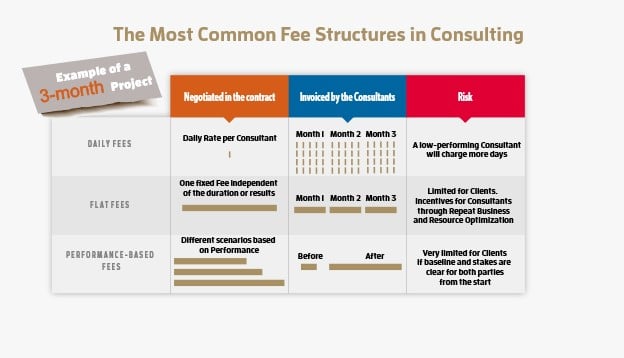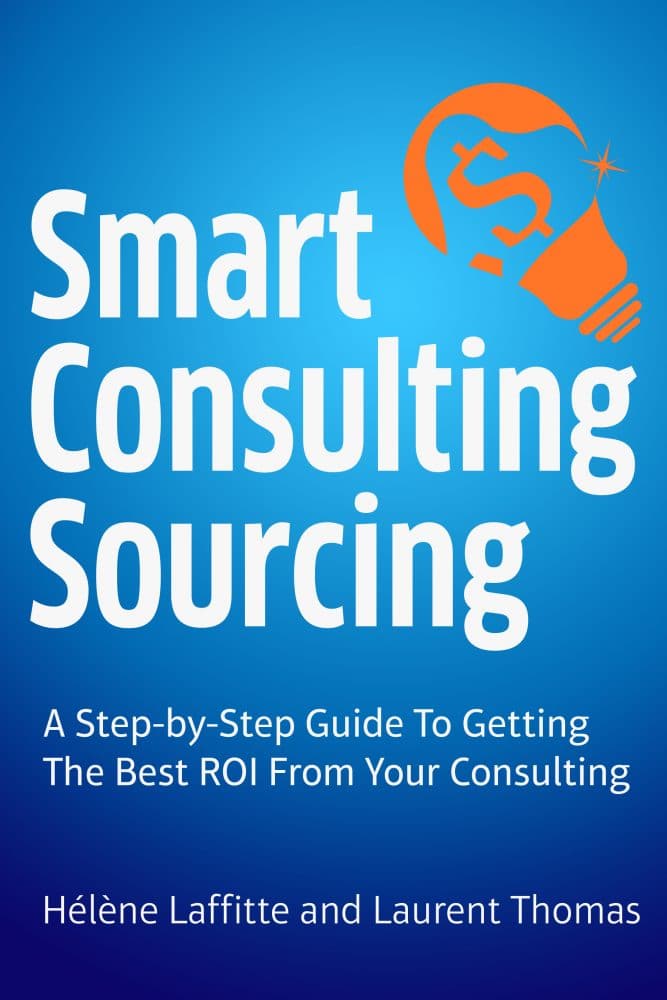
What compensation fee structure best fits your consulting project?
Consultants are selling their time, or more precisely, the access to expert knowledge and execution workforce during a certain period. The potential of production of a Consulting is the amount of time available for billing.
What compensation fee structure best fits your consulting project?
Every day not billed is lost, just like an empty airplane seat. So the fee structure is usually geared to optimize the utilization rates.
“Sell the results, not the nuts and the bolts.” – Richie Norton, a marketing strategist
As for products or services you might be more familiar with, this ranges from Cost Plus to Value-Based.
READ ALSO
Many executives have the feeling that the consulting spend should more or less remain the same for one year to the next.

1. Deliverable-based fees or flat fee –
Most Consulting firms use the flat fee structure for their projects. The Consultant will evaluate the work to be done and staff a little team. The total fee will reflect the total cost of the team to provide the work.
Pros:
The Consulting team will do the work even if the workload is higher than expected. The risk for the Client is limited.
Incentives for the Consultants are through repeat business and resource optimization.
It is particularly efficient with projects with clear requirements, fixed duration, and little to no interdependencies with the rest of your organization.
Cons:
The Client pays the amount agreed, even if the consulting team does the work faster than expected. The Consultant can be tempted to “supercharge” their resources to mitigate the risks. The Consultant can allocate resources to the proposal that will never work on the project to create a buffer.
2. Time-based fees or daily rates –
This system is very common, in particular with small projects and independent consultants. It can also apply to interim management assignments. The Consultant will define a daily rate and invoice the Client based on the number of days actually worked for the Client.
Time-based fees will be perfect for projects where you mostly need extra arms and legs, such as interim management or spot team reinforcement.
Pros:
The Client will only pay for the work done and time spent.
The fee structure is particularly transparent and adapted to projects with a finite duration. It also applies well when the requirements are not clear.
Cons:
A low-performing consultant will charge more days. Besides, the incentives for the Consultants are to stay longer to charge more. And what happens if you are not available and the work cannot progress as planned? The Client has little control over the total cost of the project. The risk is mostly on the Client’s side.
3. Retainer-based fees –
When a client needs continuous part-time support, s/he can opt for retainer-based fees. The Consultant and the Client agree on several days per week/month/quarter where the Consultant will be on “stand-by.” The retainer can be paid in a lump sum or monthly, independently of the work done by the Consultant.
Pros:
The Consultant has to stay on top of the Client’s organization and priorities. The Client is sure to have access to the Consultant for the agreed period. This type of model works particularly well when deliverables are unclear and can change during the assignment.
Cons:
The consultants can have several projects at the same time.
The “retainer” client is not always their #1 priority as that project is secured. Some consultants tend to consider retainers as paid commercial time.
4. Value-based Pricing –
More and more consultancies are exploring ways to share the value with their clients. The movement started with Bain & Company when they moved from pure strategy work to more operational support.
Value-based pricing is a pricing strategy where the prices are set not on time and materials or cost + margin, but rather on the perceived value for the Client of the service delivered. For Consulting services, it could be a share of the savings realized in a cost-cutting project.
Pros:
The clients and the consultants share the same interests: the more value created, the more value for each party. The risk for the Client is very limited. The Client only has to commit to a small flat fee.
Value-sharing fees make sense when the stakes are high, and you expect the consultants to go above and beyond their normal delivery by aligning their interests with yours and giving them, beyond the sole repeat business, the perspective of a substantial upside in case of success. Typical projects will include cost-saving programs, pricing optimization, and a new business launch.
Cons:
The baseline and the conditions of success have to be defined very precisely so the Client doesn’t end up paying more than the value really created. The model is more difficult to apply for intangible deliverables with no direct, measurable impact on P&L. Traditional consultancies are reluctant to use this fee structure that does not fit their pricing and risk management models (you cannot reserve a team of four consultants from the pool when the payment for only two can be secured).
To mitigate the risk, you will have to implement governance to ensure the activities (and how they are performed) align with your overall strategy and culture. Indeed, the consultants will take a very active role in the execution of the project, but you stay at the helm. And what are the expectations beyond their normal job that would justify a special bonus?
In conclusion, you can identify the fee structures that will yield more value for your company for each project. It will depend on the type of project, the nature of the deliverables, the context of the project, the flexibility you have on fees, and the level of commitment you expect from the Consultant
Consulting sourcing tips

How to negotiate framework agreements for consulting to your advantage?
How to negotiate framework agreements for consulting to your advantage?

Make-or-buy for consulting services 101
Make-or-buy for consulting services 101

How to Hone to Perfection Your Consultant Selection with Our Top 5 List of Attributes
You are moving forward with the project and close to making a final selection of your Consulting provider. Based on the proposal assessment described in one of our previous articles, you should now have a good sense of what the Consultant can do for you, on paper.
Previous Weeks’ issues

Holiday Season Reflections: Top Themes in Consulting 2024 | This Week in Consulting
In this edition of this week in consulting, we embrace the holiday season by reflecting on 2024’s key trends like generative AI, sustainability, and social impact.

The Changing Tide of International Trade | This Week in Consulting
In this edition of This Week in Consulting, we explore how regions contribute to global trade, the challenges they face, and the opportunities to adapt amid shifting geopolitics and policies.

Digital Transformation Decoded: Challenges, Insights, and Opportunities | This Week in Consulting
In this edition of This Week in Consulting, we delve deep into the challenges and opportunities of digital transformation across industries, offering insights to strategize, adapt, and lead.
Choose the best next step for you
Buy the Book
Talk to us
Curious how we could help your organization reach its consulting sourcing goals? Book a call today
Hélène Laffitte is the CEO of Consulting Quest, a Global Performance-Driven Consulting Platform and author of “Smart Consulting Sourcing”, a step by step guide to getting the best ROI from your consulting. With a blend of experience in Procurement and Consulting, Hélène is passionate about helping Companies create more value through Consulting.







